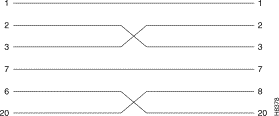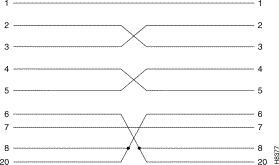|
|

This appendix provides details on the IGX 8 peripherals specifications.
Table A-1 lists the control terminals requirements.
| Parameter | Requirement |
|---|---|
IGX Port Used: | CONTROL terminal port on the SCM card is used to interface with a local control terminal. |
Code: | Standard 7 or 8-bit ASCII; 1 or 2 stop-bits; even, odd or no parity. |
Interface: | RS-232 DCE. |
Data Rate: | All standard asynchronous data rates from 300 to 19200 bps, independently software-selectable. |
Supported Terminals: | VT-100, or equivalent, recommended. |
Cable Required: | Straight-through RS-232 cable. |
The maintenance printer that is currently being shipped with the IGX is the Okidata Model 184.Refer to Table A-2 for interface requirements.
| IGX Port Used: | AUX port on the SCM card is used to interface with the maintenance printer. |
|---|---|
Code: | Standard 8-bit ASCII; 8 data bits, 1 stop-bit, odd parity. |
Interface: | RS-232 DCE. |
Data Rate: | 9600 baud. |
Supported Printers: | Okidata 184. |
Cable Required: | Straight-through RS-232 cable. |
DIP Switch A is an 8-section DIP switch located on the printer's main circuit board. Access to the configuration switches is made by sliding back the switch cover at the top, rear of the printer case. Set Switch A as indicated in Table A-3.
| Switch A | Setting | Description |
|---|---|---|
1 | Off |
ASCII with non-slashed zero. |
2 | Off | |
3 | Off | |
4 | Off | 11-inch paper. |
5 | On | |
6 | Off | No Auto Line Feed. |
7 | On | 8- bit data. |
8 | Off | Enables front panel. |
The High Speed Serial Interface DIP Switch consists of two DIP switches, SW1 and SW2, located on a serial-board that is attached to the printer's main board. Set switches 1 and 2 as indicated in Table A-4 and Table A-5.
| Switch 1 | Setting | Description |
|---|---|---|
1 | On | Odd parity. |
2 | On | No parity. |
3 | On | 8 data bits. |
4 | On | Ready/busy protocol. |
5 | On | Test select circuit. |
6 | On | Print mode. |
7 | On | Busy line selection. |
8 | On | DTR pin 2 enabled. |
| Switch 2 | Setting | Description |
|---|---|---|
1 | Off | Transmission speed = 9600 baud. |
2 | On | |
3 | On | |
4 | On | DSR active. |
5 | On | Buffer = 32 bytes. |
6 | On | Timing = 200 ms. |
7 | On | Space after power on. |
8 | Don't care | Not used. |
In general, a dial-out connection to a modem uses the AUX port of the IGX. A dial-in connection from a modem uses the CONTROL port of the IGX. Refer to Table A-6 for interface requirements.
| Parameter | Requirement |
|---|---|
IGX Port Used: | CONTROL port on SCM card is used for auto-answer modem. |
Code: | Standard 8-bit ASCII, 1 stop-bit, no parity. |
Interface: | RS-232 DCE. |
Cable: | Null modem cable. |
Phone Lines: | Dedicated, dial-up business telephone line for ISC-to-IGX modem and auto-dial-to-ISC modem. |
Data Rate: | All standard asynchronous data rates from 300 to 19200 bps, independently software-selectable. |
Supported Modems: | Motorola Model V.34R 9600 baud modem. |
This is a setup in which the ISC can dial into the customer's IGX. Using the cnfterm command, set the IGX CONTROL port speed to 9600 bps. Using the cnftermfunc command, set the terminal type to VT100/StrataView. To program the modem, temporarily attach a terminal to the modem using a null modem cable. The modem EIA port will automatically match the 9600 bps setting of the terminal. Enter the commands listed in Table A-7 to set up the modem for proper operation.
| Step | Command | Function |
|---|---|---|
1. | AT&F&W | Reset to factory default and save. |
2. | ATSØ=1 | Enables Auto-Answer Mode (answer on first ring). |
3. | ATL1 | Modem speaker at low volume. |
4. | AT*SM3 | Enables automatic MNP error correction. |
5 | AT*DC0 | Disables data compression. |
6. | AT*FL0 | Disables XON/XOFF flow control. |
7. | AT&S1 | Sets DSR to "normal". |
8. | ATEØ | Disables local character echo. |
9. | ATQ1 | Disables result codes. (Modem will appear "dead.) |
10. | AT&W | Saves current configuration settings in non-volatile memory. |
Using the cnfterm command, set the IGX Auxiliary port (AUX PORT) speed to 9600 bps and enable XON/XOFF flow control. Using the cnftermfunc command, select option 7, "Autodial Modem", enter the ISC-designated Network ID, and the ISC modem phone number. Attach a 9600 bps terminal to the modem using a cross-over cable and enter the following commands (Table A-8).
| Step | Command | Function |
|---|---|---|
1. | AT&F | Initializes factory defaults. |
2. | ATL1 | Modem speaker at minimum volume. |
3. | AT*SM3 | Enables automatic MNP error correction. |
4 | AT*DC0 | Disables data compression. |
5. | AT*SC1 | Enables DTE speed conversion |
6. | AT*FL1 | Enables XON/XOFF flow control. |
7. | AT*SI1 | Enables 5-minute inactivity disconnect. |
8. | AT&C1 | DCD controlled by modem. |
9. | AT&D2 | Modem disconnects when IGX toggles DTR. |
10. | AT&V | Verifies entries. |
11. | AT&W | Saves current settings to non-volatile memory. |
Connect the modem to the IGX AUX PORT using the cable shown in Figure A-1 . Ask StrataCom ISC to assist in testing the operation of the modem setup.
The IGX Auto-Dial to ISC application (also called "call home") and IGX Auto-Answer (call from StrataCom ISC) application use different modem cables. Figure A-1 shows the modem cable pinout for IGX Auto-Dial to ISC. Figure A-2 shows the modem cable pinout for IGX Auto-Answer (call from ISC).


![]()
![]()
![]()
![]()
![]()
![]()
![]()
![]()
Posted: Thu Oct 10 09:05:07 PDT 2002
All contents are Copyright © 1992--2002 Cisco Systems, Inc. All rights reserved.
Important Notices and Privacy Statement.